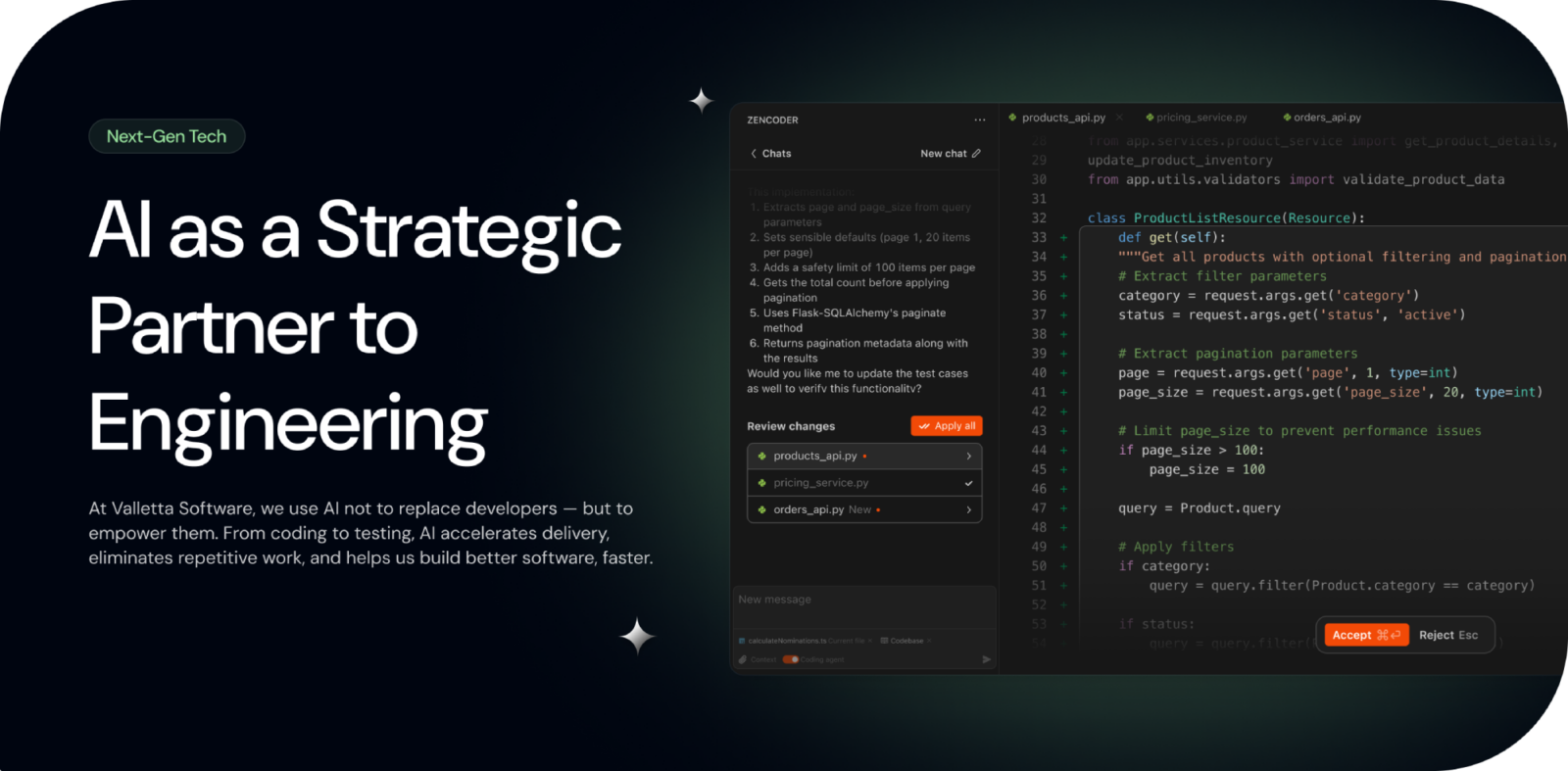AI integration for software development optimization
How Valletta Software Implemented AI to Revolutionize Its Development Processes

Project background
Overview
At Valletta Software, we’ve made it our goal to enhance our software development processes with artificial intelligence (AI). Rather than viewing AI as something that replaces our developers, we see it as a powerful tool that works alongside our team to improve productivity. We use AI at different stages of our development lifecycle, starting from clarifying requirements and generating code to refactoring and testing. By leveraging AI, we’re able to automate repetitive tasks, support complex analyses, and speed up processes that would otherwise be time-consuming. This case study demonstrates how AI helps us boost efficiency, minimize human error, and optimize the entire development workflow.
Project Goals
- Automate time-consuming development tasks to improve efficiency.
- Minimize human error and ensure a more robust, accurate codebase.
- Upgrade documentation processes to onboard new team members faster.
- Provide AI assistance in tasks such as requirements analysis, code generation, testing, and refactoring.
- Web & Mobileapp
- 10team members
- 1200+hours spent
- AI & Analyticsdomain
Challenges
- Data quality issues occurred because the input data fed into AI systems was inconsistent and inaccurate, making it hard to get reliable outputs.
- While AI offers a range of benefits, human oversight is crucial for maintaining high-quality results.
- AI requires adjustments to the development process and workflows for maximum value.
- Managing the interaction between AI and human engineers so that critical business logic is not overlooked.

Our approach
Solution
We adopted a strategic approach to integrating AI into our development process, focusing on its strengths and understanding its limitations. Our main goal was to make AI a helpful assistant rather than a replacement for our developers. By utilizing AI, we’ve been able to automate tasks that are routine and repetitive, like generating documentation, creating test cases, and refactoring code. We also leveraged AI for more complex tasks, such as task estimation and resource planning, which has significantly reduced the time we spend on these stages.
One of the key factors in successfully integrating AI was providing it with high-quality input data. By using large language models (LLMs), we’ve been able to improve tasks like requirement clarification and backlog generation. To minimize AI errors, we incorporated feedback loops that combined human oversight with AI-generated outputs for accuracy and quality.
AI was integrated into several stages of our development process. During requirements clarification, AI analyzed initial client inputs, generating clarifying questions to ensure we had a solid foundation to start from. Once the requirements were clear, AI helped draft technical specifications and create user stories and backlog items, which sped up sprint planning and improved documentation quality.
In the area of code generation, AI was used to automate boilerplate code creation, set up project scaffolds, and handle repetitive coding tasks. This allowed our developers to focus more on the core architecture and business logic. AI-powered code review tools also helped us identify performance issues, improve code readability, and ensure that our code adhered to internal style guides.
Automated testing played a major role in our solution. With AI, we generated unit and integration tests based on the project’s requirements and code structure, increasing test coverage and speeding up the testing phase. Additionally, AI assisted in generating API documentation, internal guides, and onboarding materials, cutting the time spent on documentation by three times.
Team
The team working on this project included a combination of AI engineers, software developers, and a project coordinator. The AI engineers were responsible for integrating AI tools and fine-tuning the models used for various stages of the development process. The software developers focused on implementing AI-driven solutions, ensuring they aligned with the existing workflows and codebase. The project coordinator made sure that the AI tools were aligned with project goals and requirements.
Results
By integrating AI into its development processes, we achieved substantial improvements in time, efficiency, and quality. The company reduced time-to-market, accelerating the completion of critical tasks like requirement analysis, specification drafting, and test case generation. AI-driven code refactoring and performance optimization contributed to a 10x improvement in processing speeds for some legacy codebases, reducing the turnaround time for tasks that previously took weeks.
Documentation workflows were accelerated by 3x, enabling faster onboarding of new team members and ensuring that project knowledge was consistently maintained. Automated testing not only sped up the testing phase but also improved test coverage, allowing QA engineers to focus more on exploratory testing and less on repetitive test case creation.
Achievements
- Reduced time-to-market by 40%.
- Improved team efficiency and reduced error rates by 30%.
- Increased test coverage by 50% and achieved a 10x speedup in code refactoring.
More Projects

- softwaredevelopment
- machinelearning
- webapp

- saas
- python
- webapp




